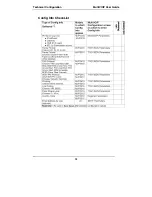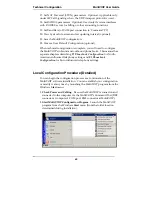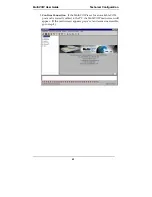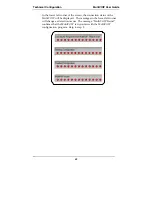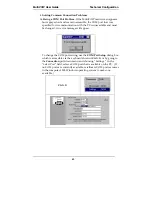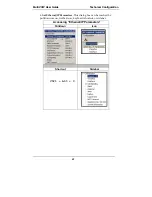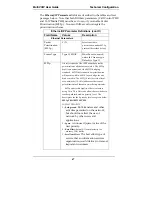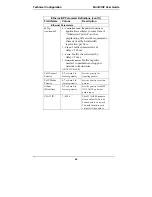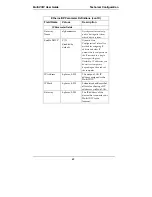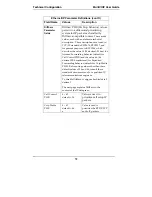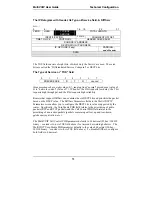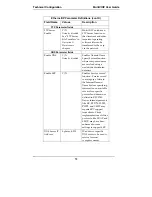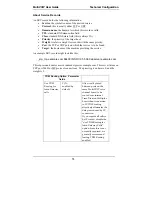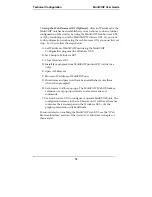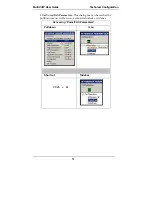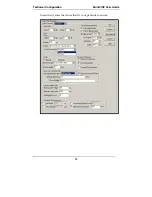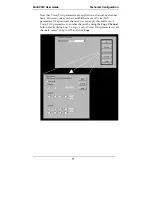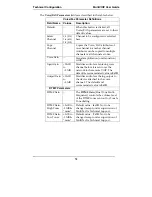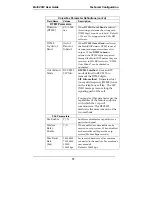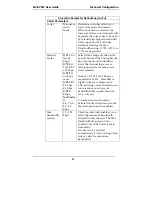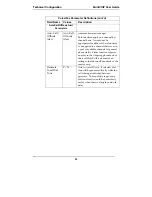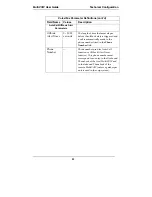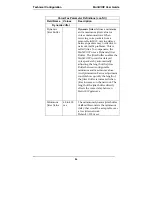
MultiVOIP User Guide
Technical Configuration
71
The IP Datagram with Header, Its Type-of-Service field, & DiffServ
bits =>
0
4
8
16 19
24
31
VERS HLEN
TYPE OF
SERVICE
TOTAL LENGTH
IDENTIFICATION
FLAGS
FRAGMENT OFFSET
TIME TO LIVE
PROTOCOL
HEADER CHECKSUM
SOURCE IP ADDRESS
DESTINATION IP ADDRESS
IP OPTIONS (if any)
PADDING …
end of header
DATA
…
The TOS field consists of eight bits, of which only the first six are used. These six
bits are called the “Differentiated Service Codepoint” or DSCP bits.
The Type of Service or “TOS” field
0 1 2 3 4 5 6 7
PRECEDENCE D T R
unused
three precedence have eight values, 0-7, ranging from “normal” precedence (value of
0) to “network control” (value of 7). When set, the
D
bit requests low delay, the
T
bit
requests high throughput, and the
R
bit requests high reliability.
Routers that support DiffServ can examine the six DSCP bits and prioritize the packet
based on the DSCP value. The DiffServ Parameters fields in the MultiVOIP IP
Parameters screen allow you to configure the DSCP bits to values supported by the
router. Specifically, the Voip Media PHB field relates to the prioritizing of audio
packets (RTP and RTCP packets) and the Call Control PHB field relates to the
prioritzing of non-audio packets (packets concerning call set-up and tear-down,
gatekeeper registration, etc.).
The MultiVOIP Call Control PHB parameter defaults to 34 decimal (22 hex; 100010
binary – consider vis-à-vis TOS field above) for Assured Forwarding behavior. The
MultiVOIP Voip Media PHB parameter defaults to the value 46 decimal (2E hex;
101110 binary – consider vis-à-vis TOS field above). To disable DiffServ, configure
both fields to 0 decimal.
Summary of Contents for MULTIVOIP MVP-3010
Page 6: ...6 Chapter 1 Overview ...
Page 28: ...28 Chapter 2 Quick Start Instructions ...
Page 38: ...Technical Configuration T1 E1 MultiVOIP User Guide 38 Chapter 4 Software Installation ...
Page 49: ...49 Chapter 5 Technical Configuration ...
Page 58: ...Technical Configuration MultiVOIP User Guide 58 Config Info CheckList ...
Page 117: ...MultiVOIP User Guide Technical Configuration 117 ...
Page 139: ...MultiVOIP User Guide Technical Configuration 139 ...
Page 170: ...170 Chapter 6 T1 Phonebook Configuration North American Telephony Standards ...
Page 184: ...T1 Phonebook Configuration MultiVOIP User Guide 184 3 Select Inbound PhoneBook List Entries ...
Page 208: ...208 Chapter 7 E1 Phonebook Configuration European Telephony Standards ...
Page 252: ...252 Chapter 8 Operation and Maintenance ...
Page 257: ...MultiVOIP User Guide Operation Maintenance 257 The Call Progress Details Screen ...
Page 265: ...MultiVOIP User Guide Operation Maintenance 265 The Logs Screen ...
Page 277: ...MultiVOIP User Guide Operation Maintenance 277 ...
Page 280: ...Operation and Maintenance MultiVOIP User Guide 280 T1 Statistics Screen ...
Page 288: ...Operation and Maintenance MultiVOIP User Guide 288 ...
Page 343: ...343 Chapter 9 Warranty Service and Tech Support ...
Page 347: ...347 Chapter 10 Regulatory Information ...
Page 352: ...352 Appendix A Cable Pinouts ...
Page 358: ...358 Appendix B TCP UDP Port Assignments ...
Page 360: ...360 Appendix C Installation Instructions for MVP428 Upgrade Card ...
Page 365: ...MultiVOIP User Guide Index 365 Index ...
Page 395: ...395 S000384A ...


